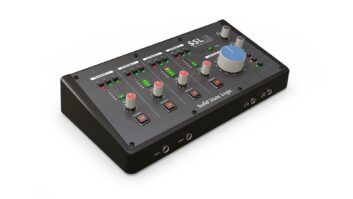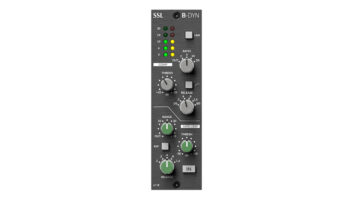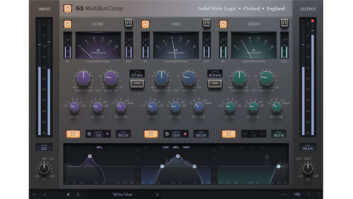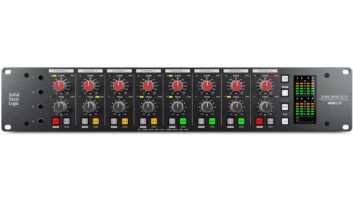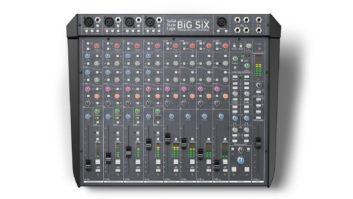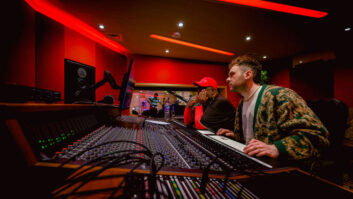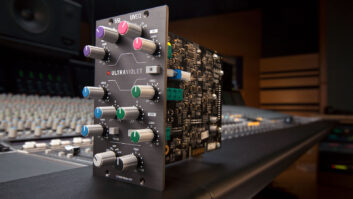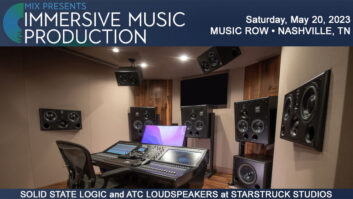First came the Alesis ADAT and Tascam DA-88, which started the whole democratization of the audio industry by making good-sounding equipment available at a low price. Then, as computers became more powerful, along came products like Digidesign’s Pro Tools, paving the way for affordable digital recording and editing on the desktop. Soon after came low-cost digital audio cards for PCs and Macs, which, combined with integrated MIDI sequencers, started appearing on musicians’ computers everywhere.
What was left? Well, users wanted digital mixing consoles, and the manufacturing community responded, with Yamaha beating everyone to the punch with the introduction of the o2R.
For the few years following the o2R’s introduction, the industry seemed obsessed with all things digital. High-end commercial studios certainly were in no hurry to retire their Neve, SSL and Euphonix consoles, yet smaller studios and offline editing suites in the post-production community gobbled up digital boards like there was no tomorrow.
But somewhere along the road to Mecca, we rediscovered those unique and admirable qualities that, in many respects, digital couldn’t quite deliver. Before we knew it, we were putting some of our older analog equipment back into service.
With a high percentage of music and audio production being performed in project or personal studios, the venerable 8-bus recording console has firmly established itself as the de rigueur mixer of this new-generation facility. Regardless of your preference, there are some incredible 8-bus boards available-both analog and digital. The time is right to take a look at the available choices.
The Contenders
The various makes and models are listed here in alphabetical order to ensure fairness. As you review the information on the various digital mixers, bear in mind that many of the input configurations take the digital inputs into account, and, as such, the number of analog XLR and line level inputs frequently don’t add up to the sum total. Also, numerous accessory products from both the original manufacturer and third-party sources can enable you to convert these digital inputs to additional analog inputs if desired. For more information on any of these consoles, see the manufacturer’s sidebar.
Allen & Heath GS3000 (Analog)
Available in 24- and 32-channel configurations, Allen & Heath’s GS3000 provides a 4-band EQ section that can be split HF/LF, and twin parametric mids between the channel and monitor paths. The GS3000 has faders on both the channel and monitor paths and incorporates two valve preamps, enabling engineers to take advantage of the traditionally warm tube sound. of equal importance, the GS3000 does not require fader swapping when going from tracking to mixdown modes. The mixer supports group/direct switching, incorporates full facilities for studio and control room monitoring and can interface with three 2-track master recorders. A meter bridge is optional.
The GS3000 employs vertical-mount PCBs throughout its construction and is housed in an all-metal frame. Standard amenities include 4-LED metering on each input, solo-in-place and PFL on both signal paths, and six aux sends on each channel that can derive their signal from either the channel or monitor paths. The mixer has facilities for MMC transport control of externally connected recorders and will accommodate either 56 or 68 inputs at mixdown.
Behringer Eurodesk (Analog)
Featuring 24 dual-input channels, the Behringer Eurodesk is an in-line design with integrated meter bridge, 4-band EQ with sweepable mids, eight subgroups, 24 balanced tape inputs/outputs (switchable +4/-10 dB), discrete mic preamps (+48V) and 100mm Panasonic faders. A universal expander port can link the mixer to another Eurodesk (or any other console) for expansion.
The Eurodesk has facilities for solo-in-place and PFL, plus six stereo effects returns and six (pre/post switchable) aux sends available on both signal paths. The mixer has a built-in talkback mic, ten 12-segment bar-graph LED meters with peak/hold capability and a rackmount 400-watt power supply.
Carvin Studio/Live SERIES (Analog)
Available in 24-, 40- and 56-channel configurations, Carvin’s Studio/Live Series consoles feature 4-band, high and low shelving with dual-mid sweep EQ on each channel, plus bypass facilities. All channels offer direct outputs with balanced TRS connectors, tape in and line in (each with balanced TRS jacks), balanced XLR mic inputs (with phantom power and TRS channel inserts), 100mm Alps faders and Analog Devices SSM2017 devices for the mic/line preamps. By flipping the channel and monitor paths at mixdown, engineers can employ the channel inputs for live or virtual MIDI inputs-effectively doubling the input capacity of the mixer.
The Carvin Studio/Live Series consoles are housed in an all-steel chassis-including the meter bridge, which is standard. The rackmount 400-watt power supply connects to the console with a standard, readily available 4-conductor Speakon cable.
Mackie 8-Bus Series (Analog)
Mackie Designs has earned an enviable reputation in the mixer market for both its analog and digital offerings. Available in 16-, 24- and 32-channel configurations, the Mackie 8-Bus Series analog consoles are both expandable and automatable. Each channel strip provides a balanced XLR mic input, a line input, direct out, channel insert and channel trim. The mixer’s EQ provides high and low shelving, parametric mid and a sweepable low/mid control. Each channel also has a low-cut filter, and a “Mix B” position effectively doubles the number of inputs at mixdown. The mixer has facilities for solo and mute (with associated LEDs) per channel and provides 100mm faders. A meter bridge is optional.
The Mackie 8-Bus consoles have extensive control room and studio monitoring provisions and incorporate a built-in talkback mic for communication purposes. The 24- and 32-channel models have an expander port for the optional 24-E expander module, which adds 24 channels.
Mackie D8B (DIGITAL)
The Mackie D8B’s 56 nominal inputs include 12 phantom-powered XLR mic pre/line inputs, 12 line inputs and 24 channels of optional ADAT, TDIF, AES/EBu or analog I/o using 24-bit A/D and D/A converters. Eight additional channels of I/o are available via an extra analog/digital card slot. The D8B provides 12 aux sends per channel with eight bus outs. The D8B accesses tracking, mixing, groups/buses and effects returns using a single “stacked” 24-channel fader bank. For 2-channel digital I/o, AES/EBu and S/PDIF formats are included. Both moving fader and dynamic snapshot automation recall all console changes. The D8B provides four types of 4-band parametric EQ, plus compression and gates on all 48 channels. An optional Apogee card provides ultra-low-jitter clock.
The Mackie D8B uses an external, rackmountable enclosure housing 32-bit Pentium processors and a hard drive for saving automation files. The CPu powers an optional PC-compatible SVGA monitor for displaying system parameters, setups, EQ curves, etc., and accommodates a standard PC keyboard and mouse. The D8B also includes Apogee uV22 bit-rate-reduction technology, an integrated meter bridge and an Ethernet connection, which facilitates software upgrades and console cascading. Additionally, Massenburg mastering EQ, Drawmer dynamics, Antares Auto-tune, and bundled TC effects are among the supported software plug-ins.
oram Series 8 (Analog)
John oram’s Series 8 adopts the company’s “no compromise” sound philosophy by using what the company describes as “the very best components, the magic of oram’s circuitry design plus the very latest surface mount technology.” This 24-channel console uses Analog Devices components for its preamplifier circuitry. In addition to its shelving EQ, the mixer provides a variable low-cut filter and a high-cut button that is designed to filter RF interference by placing a set of filter laws in the audio path. Each channel has a direct output, which can be trimmed by the Aux 5 send pot-enabling this mixer to accommodate 24-track recording.
The Series 8 provides seven aux sends per channel with five effects returns. The main channel path uses 100mm faders, while the monitor path uses 60mm faders. The mixer has two separate stereo mix outputs with master faders, AFL, solo-in-place, PFL and mute on each channel. There are talkback facilities, a sub-bass output that employs an internal crossover and an external power supply. The mixer will accommodate 72 inputs at mixdown.
Panasonic DA7 (Digital)
The Panasonic DA7 digital mixer features a 38-input (8 mic XLR/8 line level), 8-bus design, with optional expansion cards to accommodate ADAT, TDIF, AES/EBu and S/PDIF digital formats. The DA7 provides snapshot (with 50 scenes plus a lockout feature) and moving fader dynamic automation, with 21 moving faders plus support for surround panning capability. The DA7 4-band parametric EQ and dynamics on every channel, but has no onboard multi-effects processing. This mixer has an “analog feel” because it provides dedicated controls for EQ, dynamics, pan, aux and bus assignments. The DA7 also has facilities for controlling external devices via MIDI Machine Control and provides support for 5.1 mixing. A variety of digital I/o cards, a meter bridge, a SMPTE sync card and expanded automation software for either Mac or PC are optional.
The DA7 employs 24-bit A/D and D/A converters, and two mixers may be interconnected with full bi-directional control. The DA7 provides a large variable-contrast backlit display for checking system parameters. Phantom power is supported.
Roland VM-7200/7100/C7200/C7100 (Digital)
Roland’s VM-7000 Series digital mixing system is unique because it provides separate hardware for processor and control surface. With onboard dynamic moving fader automation, input capacity for as many as 94 channels, 40 XLR mic/line inputs, total recall including Trim, 16 stereo onboard multi-effects and a “virtual patchbay” for defining input destinations, the VM-7000 Series can be tailored to fit different types of production environments. Accessories include the DIF-AT Interface Box for connecting ADAT and TDIF MDM recorders, the AE-7000 8-channel AES/EBu interface, the ADA-7000 analog expander, the VS8F-2 Effects Expansion Board and the Ro-C7100 rackmount adapter kit for the VM-C7100 controller.
The separate-components design approach eliminates the need for analog splitters or snakes, thus reducing the possibility of signal degradation or noise. This arrangement also enables the processor (which includes all inputs) and mix controller to be placed where they provide the greatest functionality for the studio. The system’s FlexBus functions facilitate as many as 24 individual buses with eight dedicated analog outputs per processor plus 16 assignable outputs-all of which can be freely assigned for aux or record functions. The VM-7000 Series also provides 4-band parametric EQ and support for 5.1 mixing.
Roland VM-3100/VM-3100Pro (Digital)
Both the VM-3100 and VM-3100Pro have 24-bit A/D and D/A converters, snapshot automation, dynamic automation via MIDI, onboard stereo effects and a comprehensive backlit LCD display. The VM-3100 provides a 12-channel, 8-bus-by-2 configuration with 3-band EQ, while the VM-3100Pro offers 20 channels (using R-BuS) and eight buses. The VM-3100Pro also has a second effects processor that incorporates CoSM (Composite object Sound Modeling) microphone simulation and speaker modeling technology, plus Roland’s proprietary R-BuS I/o terminal for connection of the DIF-AT Interface Box, which enables connection to ADAT and TDIF equipment. options include the DIF-AT Interface Box, the AE-7000 8-channel AES/EBu interface and the ADA7000 analog expander.
Soundcraft Ghost (Analog)
Soundcraft’s Ghost is available in 24- and 32-channel configurations with either 56 or 72 inputs at mixdown. The console’s 4-band EQ incorporates two fully parametric mid-bands with variable Q, plus high and low shelving on each input channel. This console offers ten aux buses and two stereo pairs with four stereo effects returns. Additionally, the console’s in-line design facilitates the splitting of EQ and muting functions to either the main or Mix B (monitor) signal paths as needed. There are also provisions for solo and cut on both the main and Mix B signal paths. Balanced XLR inputs reside on all input channels, with individually switchable phantom power. Soundcraft also offers an optional 24-channel expander unit that accommodates a total of 48 inputs at mixdown.
The Soundcraft Ghost provides extensive support for MMC-based transport control of external recorders-complete with an integrated jog/shuttle wheel. For MIDI control of external equipment, Group faders 1-4 can be configured to govern effects units or other equipment that will respond to MIDI continuous controller data. The Ghost provides four internal mute groups, phase reverse, solo-in-place and PFL. The Ghost is also available in a simpler LE version, which omits the MIDI Machine Control, mute automation and mute groups.
Speck Electronics XTRAMIXcxi (Analog)
With a total of 76 inputs, the Speck XTRAMIXcxi is a four-rackspace, 40x8x2 mixer that provides 20 stereo line inputs, eight stereo effects returns and has facilities for 8-channel monitoring. Billed as a mixer that can make the “console-less studio a reality,” this compact board can accommodate a wide range of signals (-20dB to +28dB) from keyboards, samplers, playback equipment and signal processors. Its Master section has eight discrete subgroup level controls with the ability to accommodate 8-track in-line monitoring, in addition to the stereo program, stereo monitor and headphone controls. The stereo cue and aux returns facilitate a variety of signals that can be mixed with the primary input signals to the monitor and headphone outputs.
The XTRAMIXcxi uses an external, regulated power supply. Its ten-segment Vu meter consists of a series of tiny LEDs and indicates the relative levels of the stereo program and the eight subgroup outputs. unusual for a mixer of this variety, the XTRAMIXcxi provides a talkback section with an internal microphone.
Spirit by Soundcraft Digital 328
Spirit’s Digital 328 is unique in that it provides 16-track support for both the ADAT and TDIF digital protocols and does not require expansion cards. The 328 is configured as a 32-input (16 XLR/16 line level), 8-bus mixer, with support for 2-channel AES/EBu and S/PDIF digital I/o; it utilizes 24-bit A/D and D/A converters. There are two Lexicon multi-effects processors, plus dynamics processing, onboard. The 328 provides snapshot and dynamic automation of all console parameters with moving faders and 100-scene memory. Phantom power is supported. options include a TDIF-to-mic preamp, a TDIF-to-analog expander and a TDIF-to-AES/EBu converter.
The 328 provides 3-band parametric EQ for all mic/line, tape return and stereo inputs. one particularly interesting aspect of this mixer is its “E-strip.” By selecting a channel, the lightly colored area across the center of the mixer becomes a horizontal input channel-providing immediate access to that channel’s EQ, aux sends, channel pan and routing assignments. There is a backlit LCD display, and two 328 mixers may be interconnected.
Studiomaster Mixdown Classic 8 (Analog)
Available in 16-, 24- and 32-channel configurations, Studiomaster’s Mixdown Classic 8 provides a rackmount power supply and MIDI muting capability as standard fare (a full-width meter bridge is optional). With its split design, the Classic 8 has the ability to double the number of inputs at mixdown. Each input channel features balanced mic and line level inputs, plus an additional unbalanced (Line A) input, mic/line switching, phantom power, channel insert, 20dB pad, six aux buses and 100mm faders. Each channel employs Studiomaster’s 3-band, two-sweep EQ design. This arrangement provides sweepable low and mid frequencies with high shelving, plus an EQ cut switch.
As a “split” console, the tape monitors on the Classic 8 are located separately from the input channels. The monitor section can be used for extra inputs when the tape returns are routed through input channels for remixing. This enables the 16-channel console (as an example) to accommodate as many as 34 inputs. Each of the eight subgroups has a dedicated LED bar graph, which can be switched to either the console’s upper or lower set of tape monitors.
TASCAM TM-D4000
As Tascam’s first digital mixer to employ motorized faders, the TM-D4000 provides 36 channels configured as 32 mono and two stereo-each with 4-band fully parametric EQ, six aux sends and dynamics processing. The mixer’s 16 long-throw 100mm faders are layered to facilitate control of the 32 mono channels, which may be ganged to create additional stereo pairs. For flexibility during mixdown, the console provides eight fader groups and eight cut groups. Depending on the type of equipment in-house, an engineer can add as many as three optional expansion cards: IF-TD4000 (TDIF), IF-AE4000 (AES/EBu) and IF-LP4000 (ADAT optical). A fourth card, the IF-AD4000, provides eight channels of +4dBu balanced analog I/o.
The TM-D4000 provides an onboard stereo digital effects processor. These signals can be assigned to either Aux 1-2 or Aux 5-6 and are returned at the stereo Digital In 2. Mixer channels 1-8 are the integral analog channels. These eight channels provide balanced XLR mic inputs with phantom power, 11/44-inch balanced TRS jacks and 11/44-inch TRS inserts. All A/D and D/A converters operate at up to 24-bit resolution. The console supports surround mixing and provides 80 user-definable snapshots. The TM-D4000 uses an external Windows PC for dynamic automation.
Yamaha o2R
Now running its second-generation operating system, the o2R features a 40-input (16 XLR/8 line level), 8-bus configuration, compatible with all major digital audio formats (ADAT, TDIF, AES/EBu, Yamaha). It provides snapshot and dynamic moving fader automation and supports 24-bit recording with dual 32-bit internal processors. Standard 2-channel digital I/o support includes one AES/EBu and two S/PDIF connectors. The mixer has 20-bit A/D and D/A converters and offers extensive support for MIDI remote control. Phantom power is supported. Available options include a meter bridge, a variety of cards supporting the popular multichannel digital formats and wood side trim.
Although the oldest digital mixer on the market, the o2R is among the most powerful. With four card slots, the ability to configure the mixer for a variety of digital I/o formats is one of the o2R’s key attributes. There are also provisions for adding a second card for effects processing. The o2R has a comprehensive, variable-contrast backlit LCD display and has 4-band parametric EQ and dynamics on every channel. Version 2.0 software has added improved features for automation-including timecode offset, timecode capture and surround panning capabilities. The o2R is supported by a number of third-party suppliers, including TC Electronic, Apogee Electronics and a variety of software vendors.
Allen & Heath uSA
www.allen-heath.com
Circle 201 on Product Info Card
Behringer
www.behringer.de
Circle 202 on Product Info Card
Carvin Pro Sound
www.carvin.com
Circle 203 on Product Info Card
Mackie Designs
www.mackie.com
Circle 204 on Product Info Card
oram Professional Audio
www.oram.co.uk
Circle 205 on Product Info Card
Panasonic Pro Audio
www.panasonic.com/proaudio
Circle 206 on Product Info Card
Roland Corporation u.S.
www.rolandus.com
Circle 207 on Product Info Card
Soundcraft
www.soundcraft.com
Circle 208 on Product Info Card
Speck Electronics
www.speck.com
Circle 210 on Product Info Card
Spirit by Soundcraft
www.digital328.com
Circle 209 on Product Info Card
Studiomaster Inc.
www.studiomaster.com
Circle 211 on Product Info Card
Tascam
www.tascam.com
Circle 212 on Product Info Card
Yamaha
www.yamaha.com/proaudio
Circle 213 on Product Info Card
